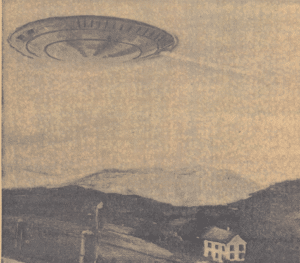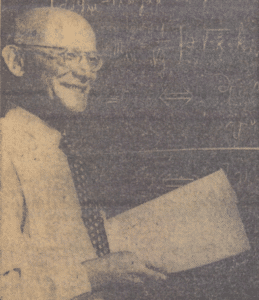By Dr. Raymond A. Keller, a.k.a. “Cosmic Ray,” author of the international awards-winning Venus Rising series of books All of Raymonds Venus Rising Books Can Be Found HERE.
BACK TO FUTURISM
Please check out the Mt Shasta Summer Conference Aug. 26th-27th by clicking this link here
From Keller Venus Files: Eugene M. Gluhareff, president of the Gluhareff Helicopter and Airplane Corporation of Manhattan Beach, California, commissioned this painting of the “Flying Saucer of the Future” and unveiled it at a late 1955 meeting of aviation and electronics company executives. According to Gluhareff, the saucer was designed “for exploring far beyond the Earth’s atmosphere and gravity field. The painting shows the flying saucer operating at “moderate speed” over the New England countryside. The business leader pointed to “a propulsive blast of the electron beams from the rear of the saucer, giving it a translational force.” He speculated that such a craft could conceivably “fly to Venus and back in thirty minutes,” since the speed of light was not even considered a limiting factor in the drive unit.
Back in 1955, other top-ranking scientists brought in to work on the anti-gravity project were Dr. Vaclav Hlavaty of the University of Indiana, who actually served with Dr. Albert Einstein on the faculty of Charles University in Prague, Czechoslovakia (now the Czech Republic), and later taught mathematics at the Sorbonne in Paris; and from the Princeton Institute for Advanced Study in New Jersey, Dr. Stanley Deser and Dr. Richard Arnowitt.
From Keller Venus Files: Dr. Vaclav Hlavaty, an associate researcher in physics with Dr. Albert Einstein in Europe, claimed the speed of light was not a limiting factor for a spaceship equipped with an anti-gravity drive.
Hlavaty and the Correct Interpretation of Einstein
Dr. Hlavaty expressed his opinion that gravity is simply one aspect of electromagnetism, the basis of all cosmic forces, and that eventually it may be controlled in much the same way that we exercise control over light and radio waves today.
While it is commonly believed that Einstein expressly declared that the speed of light was absolute and that nothing could even exist beyond this speed, Hlavaty revealed that Einstein, shortly before his death, denied that he ever made such a statement: “What Einstein did say was that around 186,000 miles per second, mass would become infinite, that your backside would become your frontside, and time, at least as we conceive it, would come to a stop. In other words, there is no reason, theoretical or otherwise, why that particular speed cannot be exceeded.”
The Czech physicist also declared that his associate in Prague, Dr. Albert Einstein, had indeed completed his major work on discovering a unified field theory that would encompass all cosmic forces in a single equation. “There is also a widely held belief,” said Hlavaty, “possibly one that has been deliberately encouraged, that Einstein’s work on his ‘unified field theory’ had not reached its final stage when his death left this work to be completed, presumably, by still other minds, yet to develop it.”
Dr. Hlavaty explained if he was stopped in his important work, there were still many others with the knowledge needed to enable them to continue his investigations into the nature of gravity, “with or without official approval.”
Finding the Gravity Key
As for Dr. Deser and Dr. Arnowitt, they shared the opinion that then recently discovered nuclear and subatomic particles of high energy, extremely hard to explain back in 1955, would prove to be the key that unlocks the mystery of gravity. It was their suggestion that the new particles might logically be seen as the basic gravitational energy being automatically and continually converted in an ever-expanding universe “directly into the most useful nuclear and electromagnetic forms.”
In a joint scientific paper on the nature of these particles, the doctors concluded that, “One of the most hopeful aspects of the problem is that until recently, gravitation could be observed but not experimented on in any controlled fashion; while now, with the advent of the past two years of the new high energy accelerators (the Cosmotron and the more recent Berkeley Bevatron), the new particles which have been linked with the gravitational field can be examined and worked with at will.”
The Cosmotron was a particle accelerator, specifically a proton synchrotron, at Brookhaven National Laboratory. Its construction was approved by the U.S. Atomic Energy Commission in 1948. It reached its full energy in 1953, and it continued running until 1966 and was dismantled in 1969. The Bevatron, built in 1954 and run by the Lawrence Berkeley National Laboratory on a hill overlooking the campus of the University of California at Berkeley, also served, and continues to serve, as an accelerator in which protons are raised to energies of several billion electron-volts by modulating the frequency of the accelerating voltage. Tasking and operation of the Bevatron is supervised by the Department of Energy.
The Interplanetary Spaceship
In the next day’s European edition of the New York Herald Tribune, on 21 November 1955, military and aviation editor Ansel E. Talbert continued with his groundbreaking series on the progress being made with anti-gravity research in the United States and the development of Earth’s first interplanetary spaceship, propelled by anti-gravitational forces, that was then already on the drawing board. Part II in Talbert’s series, “Spaceship Marvel Seen If Gravity Is Outwitted: Speeds of Thousands of Miles An Hour Without a Jolt Held Likely,” noted that since American scientists had begun to think of the Earth itself as a giant magnet, many throughout the United States aircraft and electronic industries are becoming excited over the “possibility of using its magnetic and gravitational fields as a medium of support for amazing ‘flying vehicles’ which will not depend on the air for lift.”
Talbert commented that in the near future we could expect to see “spaceships capable of accelerating in a few seconds to speeds many thousands of miles an hour and making sudden changes of course at these speeds without subjecting their passengers to the so-called ‘G-forces’ caused by gravity’s pull.” Essentially, these spaceships would mimic the power, speed and maneuverability of the flying saucers then seen peppering American skies.
The concepts that would make these types of spacecraft possible were incorporated into a TOP SECRET program that was designed to solve the secrets of gravity and universal gravitation already in progress at many of the nation’s leading scientific laboratories and long-established industrial firms. Although these scientists still did not know much about gravity and its relationship to electromagnetism, nuclear research and experimentation with “high-energy machines” in 1955, such as that conducted at Brookhaven in New York and Berkeley in California, were provided a “flood of new evidence” believed to exercise a significant bearing on attaining the goal of fabricating such a working spaceship.
*****
Keep checking out this website for Part XIII in this series, where Dr. Raymond Keller looks at the involvement and backing of William P. Lear, the inventor and chairman of the board of Lear, Inc., one of the nation’s then largest electronic firms specializing in aviation. All along, chief executive officer Lear had been watching closely and going over with his chief scientists and engineers the new theories and developments taking place related to the construction of the first American version of a workable flying saucer.



